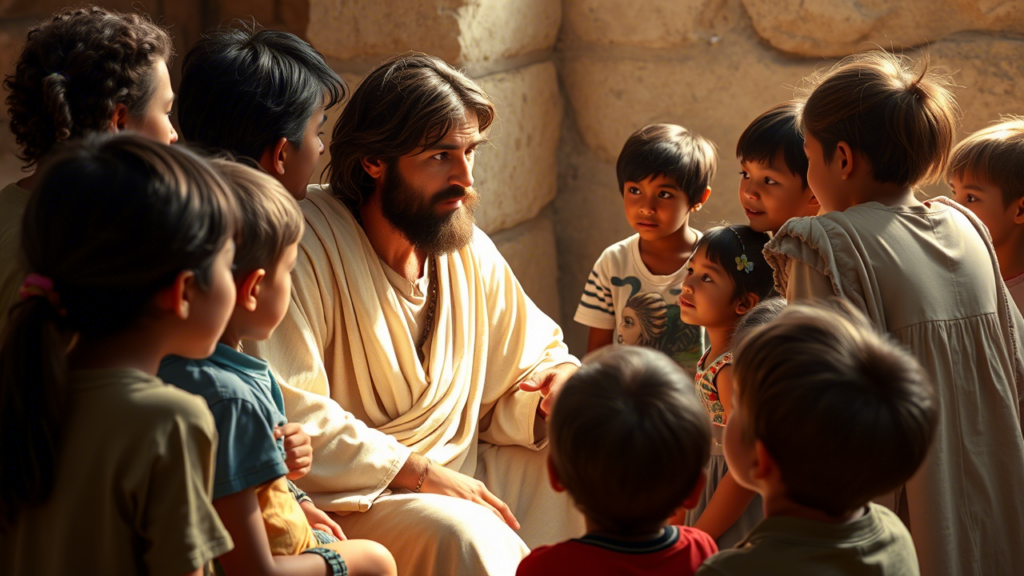Heschel Centre for Catholic-Jewish Relations at the Catholic University of Lublin
29 September, 2024
8 min
The Style of the Prophetic Speech in Jesus’ Instructions
“Jesus’ instructions in today’s gospel also resemble the style of the prophetic speeches, although they do not have exact parallels in the Old Testament books. Jesus wants us to look at the issue of acting in Jesus’ name precisely through the purpose God sets for human life”, stresses Dorota Muszytowska in her commentary for the […]

“Jesus’ instructions in today’s gospel also resemble the style of the prophetic speeches, although they do not have exact parallels in the Old Testament books. Jesus wants us to look at the issue of acting in Jesus’ name precisely through the purpose God sets for human life”, stresses Dorota Muszytowska in her commentary for the Catholic University of Lublin Heschel Center for the Sunday, September 29.
Today’s reading from Mark’s Gospel contains a brief narrative of the apostle John’s dialogue with Jesus and a series of instructive statements given by Jesus. When we listen to the word, at first, these two parts seem unrelated. Today’s liturgical readings give us the key to grasp the message of this Gospel passage as a whole. They draw our attention to the fact that God Himself and His design are essential, and all the gifts with which God endows man are to serve this truth and lead to this truth.
Let us first note the narrative quoted by the Evangelist Mark about the apostles forbidding the casting out of demons by Jesus’ authority on a man who did not follow Jesus with them.
It resembles the situation in the Book of Numbers of Joshua’s objections to Moses forbidding Eldad and Medad to prophesy. Moses had a good understanding of God’s salvific intent, revealed also in the gift of prophecy, which is well reflected in his response: “May all the Lord’s people prophesy”. He desired spiritual gifts for others and was not jealous of them. Prophecy by others in no way diminished Moses. In this narrative, it can be seen that God gives gifts to whomever He wants and how He wants them because they are meant to serve the entire community and lead them to the knowledge of God.
The apostles in Mark’s narrative here are similar to Joshua. They also misunderstood the essence of election and did not understand acting in Jesus’ name. They were unable to recognize God’s gift in the actions of the man freeing demons in Jesus’ name. Jesus’ explanations indicate that He sees the man’s act differently. Jesus does not show him as someone with exceptional knowledge and knows the truth about Jesus and His mission. However, He allows us to see that this man believed that Jesus was given the power to rule over demons and invoked His authority. This man’s conduct is not an example of false action when one usurps the power of God’s authority to support one’s ends. Therefore, it is not rebuked by Jesus. The evangelist does not inform us how this man’s faith was born. Perhaps he witnessed how Jesus freed people from the action of demons and, therefore, followed Jesus. However, he did not invoke his authority; instead, he performed miracles using the power of Jesus’ authority. Thus, through this explanation, Jesus not only corrects the disciples’ erroneous thinking, he shows them that the work of God’s Spirit is unlimited and that it is right to desire spiritual gifts given to many and abundantly. At the same time, he teaches the disciples that the ways of coming to know the truth about Jesus as the Messiah can be different.
Further instruction in this gospel passage takes on a different tone. It prompts the hearer of the Word to view who is a true disciple and follower of Jesus through the prism of the truth about the future judgment.
For a better understanding of this sudden change in perspective, the listeners of today’s Gospel are prepared by the second reading of the liturgy of the Word – from the Epistle of James. The author of this letter, referring to the teaching of the Old Testament prophets, warns the rich of the pending judgment of God. They have not adequately used wealth, a gift from God. They made themselves masters and acquired wealth as a measure of their power. Their conduct became an expression of their denial and rejection of God’s kingship, which is why severe punishment is announced to them on the day of final judgment.
Note that Jesus’ instructions in today’s gospel also resemble the style of the prophetic speeches, although they do not have exact parallels in the Old Testament books. Jesus wants us to look at the issue of acting in Jesus’ name precisely through the purpose God sets for human life. Changing the perspective to an eschatological one in this passage, that is, looking through the lens of the purpose, the end, and the results of God’s judgment, helps us understand who the disciples and followers of Jesus are.
Jesus first uses praise for the attitude of doing something for His sake. He points out that these do not have to be spectacular miracles; small and simple gestures such as a cup of water are enough. No act, even such an inconspicuous one, done for the sake of faith in Jesus, will go unrewarded. This praise is a general principle, but its meaning can be found in Jesus’ earlier comment on the behavior of a man who frees demons in Jesus’ name.
In stark contrast to this, praise is a warning to those whose conduct will be contrary – that is, it will contribute to scorning those who believe in Jesus. The point is not that someone will not perform works for the sake of Jesus, that is, without faith in him, but such conduct contributes to doubting or losing faith in Jesus.
The comparison on which this warning is based can be controversial and is often misunderstood. The value of life in God, the value of faith, and what it is to lose it are emphasized above all in this intensified statement through the image of a millstone attached to the neck of the guilty party and thrown into the sea. Faith in Jesus gives life. So, depriving someone of faith in Him is shown as a crime that deserves severe punishment.
This warning begins a series of highly eloquent instructions. Listening to the word prompts one to grapple with the message behind the hard-to-accept wording, recommending drastic solutions.
Of course, these recommendations should not be taken literally. As in the case of the above warning, the language is intended to highlight as best as possible the need for radicalism in changing spiritual attitudes.
Note that in all these recommendations, Jesus encourages getting rid of something that is good in itself, a Divine gift, and needed or may even seem necessary—symbolized by the hand, the leg, and the eye. With this figurative language, Jesus eloquently shows that if anything of God’s gifts obscures or replaces their Giver to a person, it becomes the cause of a curse for that person.
Jesus points out that the problem lies not in the gift itself but in the man who misuses God’s gifts. It doesn’t matter whether the gifts are material or spiritual. What matters is that such a situation calls for active action on the part of man, who should always remove the causes of distance from God.
Note that in all these recommendations, Jesus encourages getting rid of something that is good in itself, a Divine gift, and needed or may even seem necessary—symbolized by the hand, the leg, and the eye. With this figurative language, Jesus eloquently shows that if anything of God’s gifts obscures or replaces their Giver to a person, it becomes the cause of a curse for that person.
Jesus points out that the problem is not in the gift itself but in the person who misuses God’s gifts. It doesn’t matter whether the gifts are material or spiritual. What matters is that such a situation calls for active action on the part of man, who should always remove the causes of distance from God.
These words of Jesus teach that any lack or loss is entirely incomparable to the inability to be in God’s Presence. The stakes are high – it is either life, i.e., the experience of the fullness of the reality of the Kingdom of God, or the absence of this Presence, which is identified in this Gospel passage with Gehenna, its unquenchable fire and vermin.
The term Gehenna used here is very telling. The Valley of Gehenna is the Greek version of the name Ge-Hinnom, a valley extending from the south side of Jerusalem. In the past, the Valley of Hinnom was a place of idolatrous worship, where, most likely, child sacrifices were offered by burning to Moloch, as alluded to in Old Testament texts, such as Leviticus, 2 Kings, and Jeremiah.
In Jewish tradition, the valley symbolizes a place of suffering, punishment, and a place of damnation. In the time of Jesus, the valley served as a dumping ground where waste was burned; adding sulfur to keep the fire burning and burning faster aroused revulsion and was associated with something hideous and disgraceful. So, Jesus uses the term not coincidentally to illustrate life without God. It is not difficult to understand why, in the Christian tradition, the term Gehenna has become a symbol of hell.
The pattern of the “two ways” motif can be seen in these specifically structured instructions of Jesus. This motif is well known, for example, from the 30th chapter of Deuteronomy, where God indicates that man has a choice between life and death, blessing and curse, and encourages him to choose life. Similarly, the Psalmist (Ps. 1) shows two possible paths of conduct: the righteous and wicked man and the corresponding end associated with each choice.
Jesus’ teachings point to the need for constant choice. Being a disciple of Jesus demands choosing what leads us to life in God and rejecting everything that detracts from it. This radicalism stems from the fact that there is no other way; choosing the opposite leads to the fires of Gehenna.
Thus, in Jesus’ instructions, the cause of scorn leading someone to lose their faith and any conduct that leads us to lose our faith is shown in choosing the path of death and damnation. A true disciple of Jesus rejects everything that distances them from God and opposes God, thus becoming a follower of Jesus.
Related

Explaining Holy Week to Our Children: A Journey of Faith and Hope
Laetare
11 April, 2025
4 min

Christian Leadership in Business: A Model of Humility, Justice, and Solidarity
Javier Ferrer García
10 April, 2025
3 min

Guiding Our Decisions with God’s Will in Daily Life
Patricia Jiménez Ramírez
10 April, 2025
4 min

What are you going to do with your life?
Luis Herrera Campo
10 April, 2025
2 min
 (EN)
(EN)
 (ES)
(ES)
 (IT)
(IT)

